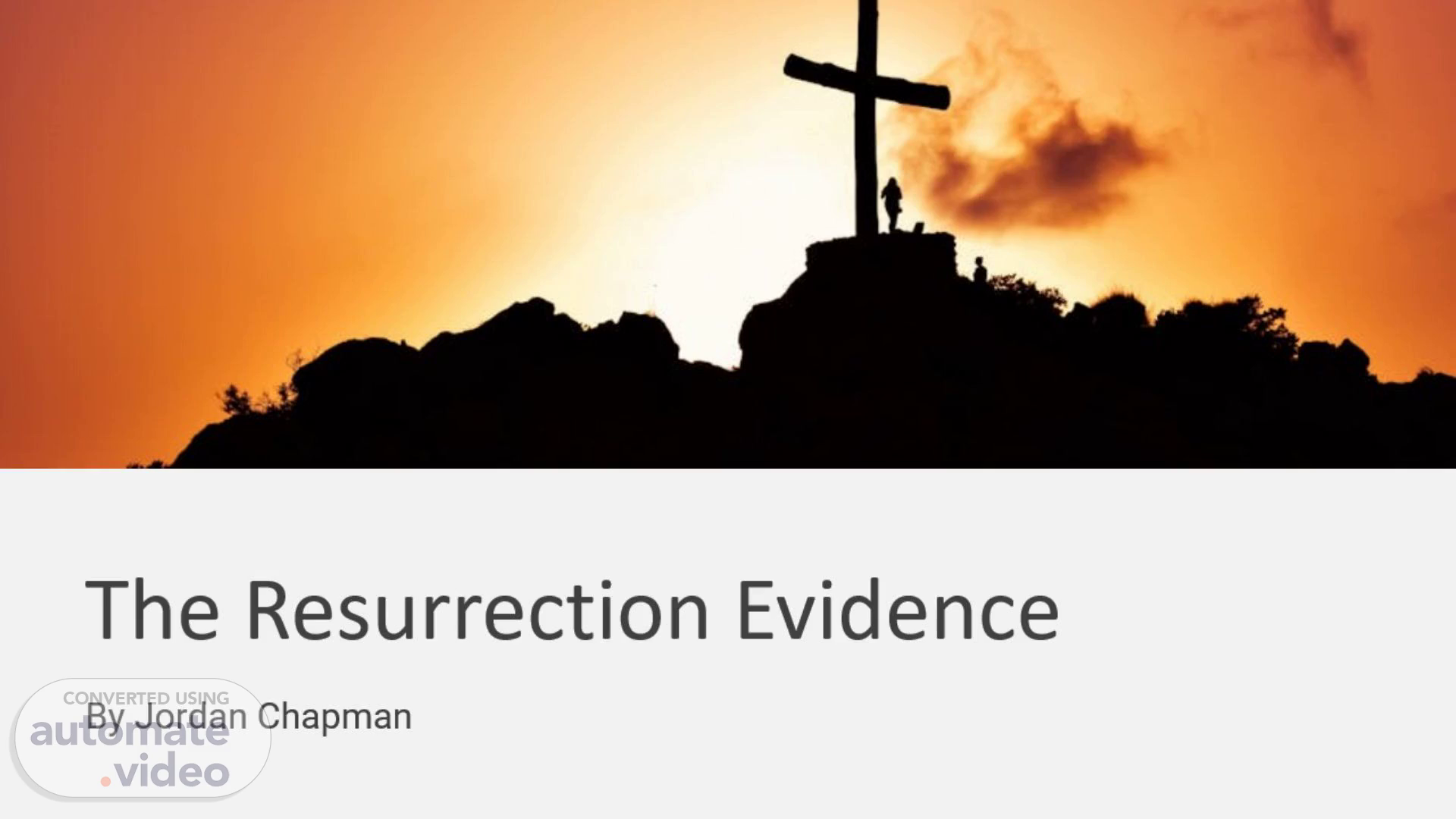Scene 1 (0s)
[Audio] "Good morning/afternoon, everyone, and thank you for being here. Today, I'll be presenting on the historical and scientific evidence for Jesus' resurrection. My name is Jordan Chapman, and this presentation is part of my ENGR 270 course at Liberty University. We'll explore how ancient sources, modern scholarly tools, and archaeological evidence converge to support three key claims: Jesus' crucifixion, the empty tomb, and post-mortem appearances. While this is a historical topic often tied to faith, I'll focus on an evidence-based approach that invites serious academic consideration.".
Scene 2 (42s)
[Audio] "To begin, let's summarize the purpose of this presentation. The resurrection of Jesus is one of the most debated events in history, but it's also one of the most well-documented from antiquity. This analysis focuses on three widely accepted historical claims: Jesus' crucifixion, his burial in a tomb later found empty, and multiple accounts of post-mortem appearances. Using historical-critical methods and archaeological evidence, we'll see how these claims are supported by both Christian and non-Christian sources, providing a solid foundation for academic study.".
Scene 3 (1m 21s)
[Audio] "Historical investigation differs from scientific inquiry in that historians work with probabilities, not certainties. Historians rely on documentation from witnesses or those close to events, as well as multiple independent attestations. One tool is the 'criterion of embarrassment,' which evaluates whether details that might harm the credibility of a movement—like women being the first witnesses to Jesus' empty tomb—are unlikely to have been invented. Archaeology plays a key role too. For example, discoveries of tombs and burial customs from first-century Palestine confirm important details from the Gospel accounts, helping to verify their historical reliability.".
Scene 4 (2m 7s)
[Audio] "Let's start with what most historians agree on: Jesus' crucifixion. Roman and Jewish sources, like Tacitus and Josephus, document his execution under Pontius Pilate. Archaeological evidence also supports this. In 1968, the remains of a crucified man from first-century Jerusalem were discovered, with a nail piercing his ankle bone. This aligns with ancient descriptions of crucifixion practices. The burial of Jesus is another widely accepted fact. Joseph of Arimathea, a Jewish council member, is said to have buried Jesus in his own tomb. This detail is unlikely to be fabricated, as it links a prominent Jewish leader with Jesus' burial. These accounts are consistent with Jewish burial customs of the time, which required burial before the Sabbath.".
Scene 5 (3m 1s)
[Audio] "The discovery of the empty tomb is a key part of the resurrection narrative and is supported by multiple independent sources. One notable detail is that women are described as the first witnesses to the empty tomb. In first-century Jewish society, women's testimony was not considered reliable, so this is an example of the criterion of embarrassment—early Christians wouldn't have invented this detail. Additionally, Jewish authorities claimed that Jesus' disciples stole his body. This acknowledges the tomb was empty but offers a different explanation. Archaeological studies of tombs in first-century Jerusalem also confirm the Gospel descriptions of burial practices, further supporting the historical accuracy of this account.".
Scene 6 (3m 49s)
[Audio] "The post-mortem appearances of Jesus are recorded in early Christian writings and are a central part of the resurrection claims. The earliest source is the creed in 1 Corinthians 15:3-8, written within five years of Jesus' crucifixion. It lists witnesses, including individuals like Peter, James, and even groups of over 500 people. These appearances transformed skeptics. For example, James, Jesus' brother, went from being a doubter to a leader in the early church. Paul, a persecutor of Christians, also converted after experiencing what he described as an encounter with the risen Jesus. Even non-Christian sources, like the Jewish historian Josephus, acknowledge that early Christians believed Jesus appeared to them after his death.".
Scene 7 (4m 42s)
[Audio] "Evaluating ancient claims requires rigorous methods. Historians rely on primary sources, like eyewitness accounts, and secondary sources that interpret them. Key criteria include multiple independent attestations, where different sources confirm the same event without evidence of collaboration. For example, the crucifixion of Jesus is mentioned by Roman, Jewish, and Christian sources. The empty tomb is supported by Gospel accounts and indirectly by Jewish authorities' claims of body theft. Post-mortem appearances are attested in creeds, Gospels, and by skeptics who converted. While absolute certainty is impossible, these methods establish the probability of historical events, making the resurrection a strong candidate for academic consideration.".
Scene 8 (5m 37s)
[Audio] "The resurrection had a profound impact on individuals and communities. Paul and James, both skeptics, became leaders after their encounters with the risen Jesus. Early Christians also began worshiping on Sunday instead of the Jewish Sabbath. This shift reflects their belief in the resurrection and its significance. These transformations laid the foundation for Christianity, which grew to become the world's largest religion. The resurrection not only shaped their faith but also reshaped history.".
Scene 9 (6m 8s)
[Audio] "In conclusion, the historical evidence for Jesus' resurrection is compelling. His crucifixion, the empty tomb, and post-mortem appearances are supported by multiple independent sources and archaeological findings. These elements converge to make the case for the resurrection worthy of serious academic study. The resurrection transformed individuals, altered cultural practices, and continues to influence billions of people today. Thank you for your attention, and I'm happy to answer any questions.".
